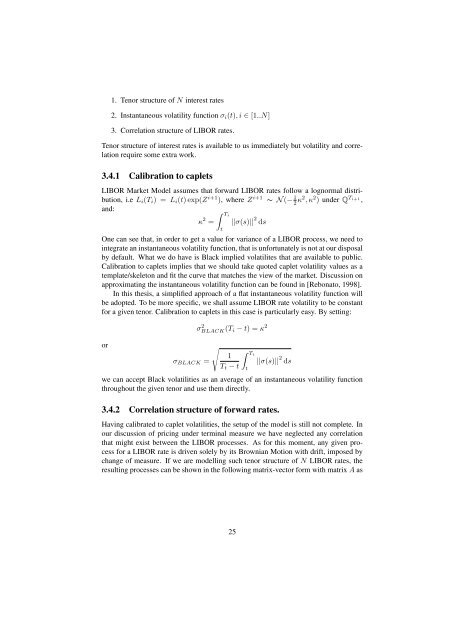sparse grid method in the libor market model. option valuation and the
sparse grid method in the libor market model. option valuation and the
sparse grid method in the libor market model. option valuation and the
You also want an ePaper? Increase the reach of your titles
YUMPU automatically turns print PDFs into web optimized ePapers that Google loves.
1. Tenor structure of N <strong>in</strong>terest rates<br />
2. Instantaneous volatility function σ i (t), i ∈ [1..N]<br />
3. Correlation structure of LIBOR rates.<br />
Tenor structure of <strong>in</strong>terest rates is available to us immediately but volatility <strong>and</strong> correlation<br />
require some extra work.<br />
3.4.1 Calibration to caplets<br />
LIBOR Market Model assumes that forward LIBOR rates follow a lognormal distribution,<br />
i.e L i (T i ) = L i (t) exp(Z i+1 ), where Z i+1 ∼ N (− 1 2 κ2 , κ 2 ) under Q T i+1<br />
,<br />
<strong>and</strong>:<br />
κ 2 =<br />
∫ Ti<br />
t<br />
||σ(s)|| 2 ds<br />
One can see that, <strong>in</strong> order to get a value for variance of a LIBOR process, we need to<br />
<strong>in</strong>tegrate an <strong>in</strong>stantaneous volatility function, that is unfortunately is not at our disposal<br />
by default. What we do have is Black implied volatilites that are available to public.<br />
Calibration to caplets implies that we should take quoted caplet volatility values as a<br />
template/skeleton <strong>and</strong> fit <strong>the</strong> curve that matches <strong>the</strong> view of <strong>the</strong> <strong>market</strong>. Discussion on<br />
approximat<strong>in</strong>g <strong>the</strong> <strong>in</strong>stantaneous volatility function can be found <strong>in</strong> [Rebonato, 1998].<br />
In this <strong>the</strong>sis, a simplified approach of a flat <strong>in</strong>stantaneous volatility function will<br />
be adopted. To be more specific, we shall assume LIBOR rate volatility to be constant<br />
for a given tenor. Calibration to caplets <strong>in</strong> this case is particularly easy. By sett<strong>in</strong>g:<br />
or<br />
σ 2 BLACK(T i − t) = κ 2<br />
√<br />
1<br />
σ BLACK =<br />
T t − t<br />
∫ Ti<br />
t<br />
||σ(s)|| 2 ds<br />
we can accept Black volatilities as an average of an <strong>in</strong>stantaneous volatility function<br />
throughout <strong>the</strong> given tenor <strong>and</strong> use <strong>the</strong>m directly.<br />
3.4.2 Correlation structure of forward rates.<br />
Hav<strong>in</strong>g calibrated to caplet volatilities, <strong>the</strong> setup of <strong>the</strong> <strong>model</strong> is still not complete. In<br />
our discussion of pric<strong>in</strong>g under term<strong>in</strong>al measure we have neglected any correlation<br />
that might exist between <strong>the</strong> LIBOR processes. As for this moment, any given process<br />
for a LIBOR rate is driven solely by its Brownian Motion with drift, imposed by<br />
change of measure. If we are <strong>model</strong>l<strong>in</strong>g such tenor structure of N LIBOR rates, <strong>the</strong><br />
result<strong>in</strong>g processes can be shown <strong>in</strong> <strong>the</strong> follow<strong>in</strong>g matrix-vector form with matrix A as<br />
25
















